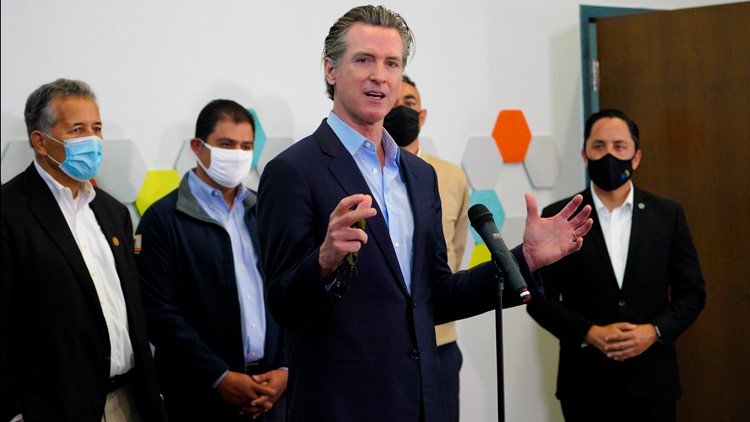This time last year, California was in Chicken Little mode, warning that the fiscal sky was falling. Today, the state’s so flush that Gov. Gavin Newsom proposes to spend big on college savings accounts for children.
But it’s not clear that his plan is the best way to do that, or if it even needs to exist, since it duplicates programs already there.
Under the plan proposed last week, the state would create savings accounts for low-income, public K-12 students with an initial deposit of at least $500. Families could add to it until it’s time for the tot to go to college. That would cost around $2 billion — all money from COVID-inspired federal stimulus — and help 3.8 million students initially.
Starting the year after, the newly created entity, the California Opportunity Fund, would deposit $500 to every first-grader in a public school who’s considered low-income or is in an English-language learning program. Foster youth and students experiencing homeless would get an additional $500. Estimates peg the annual cost at around $170 million in state money.
“This is an opportunity to address generational poverty. This is an opportunity to stretch a college-going mind,” Newsom said.
Birth or first grade?
Helping low-income families out with college savings accounts is one way to address the racial wealth chasm in the U.S., where the typical white family possesses eight times the wealth of Black families and five times the wealth of Latino families. It’s also consistent with Newsom’s goal to increase the percentage of adult Californians with college degrees by 2030 from less than 50% to 70%.
Because college savings programs are relatively new, it’s hard to say for sure whether such programs boost college enrollment, a federal analysis last year said. However, it highlighted a 2017 paper that found that Boston students given college savings accounts in middle school or high school were slightly more likely to enroll in a four-year university than a community college.
Overall, low income families don’t participate in college-savings accounts, the most popular being 529 plans. In a 2016 report, the Federal reserve calculated that just .3% of low-income families had such 529 plans.
READ MORE:
Newsom touted research from the Washington University in St. Louis tracking about 1,300 Oklahoma families with newborns who received at least $1,000 through a college savings study. Researchers have been following those families since 2008, finding that the students are “more hopeful about the future, have fewer behavioral problems, have a more positive academic self-concept, and have stronger math skills.” The findings align with Newsom’s message that these programs promote a college-going culture at home.
But that research stresses such programs need to be universal and start at birth. The governor’s proposal is neither: It kicks in once children are in first grade and only if they’re determined to be low-income. His plan also excludes students in private schools, which enrolled 7% of the state’s K-12 learners last year.
Newsom’s office wouldn’t say why his plan focused on first graders rather than newborns.
“We would like to see all children included because children’s economic conditions change over time,” said Margaret Clancy, a director of the Oklahoma experiment. Still, her team’s research shows that the biggest gains go to low-income students, so targeting kids in those families as Newsom’s plan proposes “is a positive,” she said.
Even if students’ families don’t contribute any money to the accounts beyond what the state doles out, wealth can build over time. According to the Oklahoma program researchers, the initial $1,000 placed into a child’s account in 2007 grew to $1,900 by 2019, though the value dropped to $700 early on during the Great Recession.
The later a child receives the money, however, the less time the money’s impact can have on improving the odds a child goes to college — such as creating higher expectations about pursuing a degree, increasing optimism, and influencing families to save more money for college. A later deposit also means fewer years for the account to gain interest.
Newsom’s plan ensures the money tied to a student doesn’t count against their financial aid eligibility. The point is to supplement, not supplant, a student’s cost of attending college with funds “that would not otherwise be supported by their financial aid package,” said Chris Ferguson of the governor’s Department of Finance. The funds in the accounts would be exempt from state taxes.
But that policy opens the door for some recipients who are low-income when they’re young to be better-off by the time they’re ready to attend college, and so far there’s no language to determine whether students still need the money down the line.
Already existing programs
The city of Oakland runs two child savings accounts — one that kicks in for newborns and other when children are in kindergarten. The Brilliant Baby program limits eligibility to families who receive some kind of state or federal subsidy for low-income households. Newsom already helped establish a savings account program a decade ago in San Francisco when he was mayor of the city.
Additionally, the state two years ago approved $25 million in one-time funds to open a child savings account for every child born after 2020. That program is expected to begin operations this year but the money realistically can’t last for more than a couple of years.
So it’s not totally surprising that the chief advisory group to the Legislature calls Newsom’s proposal redundant. In comments shared with CalMatters, the Legislative Analyst’s Office wrote that the state could just add money to that program rather than creating a new one. “Having one college savings account rather than two would be easier for families to navigate, thus encouraging program utilization,” the advisory group wrote.
READ MORE:
Having a statewide program reduces the chance of families losing out on money initially promised to them compared to some of the roughly dozen local college savings programs. Glendale Unified School District received a state grant to seed $50 for every first grader last year. But students can only access the money for college purposes if they graduate from a Glendale Unified high school. Newsom’s current proposal would allow students to use their accrued savings at any college in the U.S. that’s eligible for federal financial aid — the only constraint is that the money would have to be used by the time the child turns 35.
Phil Ting, budget chair in the Assembly, likes Newsom’s college savings plan but thinks there’s enough money to fund it and supersize the state’s financial aid program.
Students need financial aid support now and the cost of college forces many to drop out. For existing students — and Newsom’s own goal of increasing Californians with college degrees by 2030 — starting college savings accounts now doesn’t do a lot.
Newsom’s May budget proposal didn’t do much to broaden the state’s financial aid program, even though the Legislature is keen on significantly expanding how many students are eligible for state financial aid and increasing the aid they get. But those conversations are still ongoing — and it takes both legislators and the governor to pass a budget.
There are also limits to how the state can use its newfound bounty. The federal stimulus expires in 2024, so money from that pot has to be put to use sooner rather than later. “We’re trying to figure out how to responsibly use one-time dollars in ways that can have maximum impact,” said Lande Ajose, higher-education advisor for Gov. Newsom.



